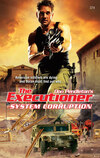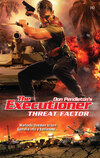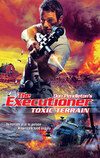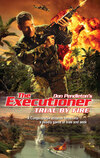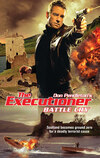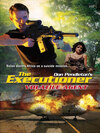Kitabı oku: «Black Death Reprise», sayfa 3
“We’ll be at the tunnel in less than five minutes,” was all Bolan said.
Zagorski nodded, knowing he was referring to a mile-long tunnel under a section of foothills that rose to become the Pyrenees Mountains separating France from Spain. The customs checkpoint, where according to Brognola, Bolan’s vehicle would already be cleared for a direct nonstop drive through, was another five miles down the road.
“Thank you, whoever you are. They were going to kill me.” Zagorski paused, swallowed hard and added in a voice more appropriate for a confessional than the interior of a sports car, “The work they made me do is evil. I tried to go as slowly as I could.”
“You did okay,” Bolan replied, keeping his eyes glued to the front. “There’s a plane waiting for us in San Sebastian.”
The road was wide and smooth, with two lanes in each direction separated by a center median in which a row of red maples had been planted at intervals of approximately twenty feet. At the speed they were traveling, the small trees whizzing past in Bolan’s peripheral vision took on the appearance of a continuous hedge.
When they reached an area in the foothills where the road turned curvy, Bolan downshifted into the first S-curve while checking the rearview mirror.
“You think they’re coming after us?” Zagorski asked. “You keep looking into the mirror.”
“We don’t want to be surprised,” he answered as he accelerated into the curve, then quickly downshifted as they raced into the next bend. Displaying the timing and reflexes of a race car driver, Bolan alternated between downshifting and accelerating, negotiating one hairpin turn after another at speeds that caused the vehicles’s high-performance tires to smoke and squeal in protest. When he entered the last S-turn ending in a straightaway that covered the final half mile leading into the tunnel, two lights characteristic in size and shape of those designed on the front fuselage of a Bell 206 helicopter jumped into his rearview mirror.
The chopper was incoming fast, at close to twice Bolan’s speed, closing the gap between them at a rate that would place the aircraft on top of the Porsche before it reached the tunnel.
Bolan slammed his foot onto the brake and jerked the steering wheel to the left, causing the sports car to slide into a tire-smoking sideways skid that painted wide rubber stripes down the center of the highway.
The helicopter pilot was not anticipating Bolan’s maneuver, and he whizzed straight past, strafing the road inches in front of the Porsche’s reinforced bumper. The .20-caliber machine-gun rounds blazing from the helicopter’s underside left deep pockmarks in the highway’s smooth surface.
As Bolan straightened his car and accelerated toward the tunnel’s entrance, the pilot pulled the nose of his aircraft upward, attempting to perform a complete reverse turn before his prey was able to reach the safety of the passageway. The pilot’s desire to align his chopper with the highway told Bolan that the machine gun was on a fixed mount. The configuration required the pilot to work with his gunner in order to get the barrel pointed generally in the right direction, a fact Bolan used to his advantage. He stomped the accelerator, and the silver sports car took off like a rocket, pressing both passengers into the plush leather seats as it sped into the safety of the mile-long tunnel.
Coming in from the dark, the brightness of the tungsten lights mounted into the ceiling made Bolan squint. There were no other vehicles in sight, and he eased off the gas pedal to give himself a few extra seconds of safety to consider his next move.
“They’ll send someone in to chase us out,” Zagorski said in a low quavering voice that made Bolan wonder if she had reached her point of exhaustion. After her performance at the monastery, he wouldn’t fault her if she had. “And the helicopter will be waiting.”
Unbeknown to her, an M-72 66 mm Light Antitank Weapon was sitting ready for use in the vehicle’s front trunk. The problem Bolan pondered was how to deploy the weapon in this particular situation. The tube in which the LAW’s missile was assembled was open at both ends, which meant the user had to account for a backblast. When the missile ignited, it sent a dangerous tongue of flame and hot gases six feet to the rear.
“We can open the roof, and I’ll fire at them as soon as we come out of the tunnel,” Zagorski said, shifting the P-90 she held at an angle between her knees.
“Not good odds,” Bolan replied. “Not with a Bell. There’s too much plate on the belly for your rounds.”
Spotting a pair of taillights ahead, he accelerated to catch up. As he got close, he saw it was a pickup truck at least ten years old, the faded paint dented and scratched in numerous places.
“We just got lucky,” Bolan said as he steered into the passing lane and tapped his gas pedal to pull even with the pickup. One of the hubcaps on the driver’s side was missing, and the metal sides around the open cargo area were pocked with large sections of maroon rust. The rocker panels had rusted completely through in so many places they appeared to be made of red lace.
“Get him to stop,” Bolan said, pressing the switch to lower Zagorski’s window.
She shouted in French to the driver, a man who looked to be in his midsixties, who first stared at her, shook his head, then stared straight forward, his hands gripping the steering wheel tightly enough to turn his gnarled knuckles white.
Bolan moved forward until the Porsche was halfway beyond the truck before he inched the steering wheel to the right, easing the car’s back fender panel into the pickup’s front bumper.
The old man started shouting and gesturing with universally understood hand signals, but with sparks flying from where the two vehicles were rubbing together, and with the vast superiority the Porsche held over the old pickup, he was forced out of the lane onto a narrow breakdown shoulder barely wide enough for a car to sit beyond the traffic’s flow.
When they had come to a complete halt with the Porsche blocking the pickup’s path, Bolan said, “Come with me,” threw his door open and jumped out. Upon reaching the truck, he reached up and pulled the driver’s door open.
The old man continued shouting and gesturing wildly until his eyes glanced at the Desert Eagle in Bolan’s left hand. Under the bright tungsten lighting, the huge handgun gleamed with evil purpose.
Zagorski stared at the gun with eyes as large as saucers, apparently as apprehensive as the truck driver that Bolan was about to shoot him.
“Tell him not to be afraid.”
Zagorski translated quickly, but her voice as well as the old man’s face belied their belief in Bolan’s words. It was obvious they were both terrified.
“Buy his truck. Fifty thousand euros,” Bolan stated in a voice that held no room for negotiation. “The cash is in the glove compartment.”
Zagorski related the message, which, because it amounted to approximately one hundred thousand U.S. dollars, was not believed. The man’s bottom lip was trembling, and his hands shook as if he was afflicted with palsy. His eyes remained glued to the Desert Eagle.
“Get the money. Hurry,” Bolan said.
Zagorski ran the few steps back to the car, reached in through her open window and came back with a wad of high-denomination bills.
“Tell him again. Fifty thousand euros.”
The sight of the money brought a smile to the old man’s face. In this part of the world, populated along an international border with a culture bred of an interesting combination including ancient Christianity, Islam and Basque, men did not pass judgment on the business of others. Within the local value system, a smuggler or drug dealer could conduct legitimate transactions as subsets of an overall illicit plan without necessarily involving a third party in anything illegal or immoral. Regardless of Bolan’s business, he was offering a transaction the old man found very easy to view as legitimate.
The old man asked for the Porsche as well.
Zagorski couldn’t help but smile as she translated the request.
“No,” Bolan answered. “It’s not mine. Someone will come by to pick it up.”
A slight smile touched at the corners of his mouth for a second as he imagined Hal Brognola explaining to the President that one of the CIA’s high-technology special mission models complete with armor plating, bulletproof glass, and a 5.56 mm machine gun concealed above the tailpipe, was being used to run errands into town by an old hay farmer in Southern France.
“No,” he said again.
The man nodded, and, with his smile exposing a mouthful of crowded, crooked teeth, took the stack of bills from Zagorski and shoved them into his pocket. Despite the fact he was bareheaded, he made a motion of tipping his cap to both Zagorski and Bolan, and set off walking back the way they had come in.
“You drive,” Bolan said, pointing to the truck as he returned to the Porsche.
Zagorski climbed into the pickup and backed it away, allowing Bolan to ease the Porsche against the wall of the tunnel to keep it as far as possible out of the traffic lane until someone could retrieve it.
After shutting down the engine, Bolan released the latch to open the car’s front trunk compartment revealing the LAW.
“Who are you?” Zagorski asked again as Bolan grabbed the LAW and pulled on both ends to expand the weapon. The inner tube telescoped outward to the rear, guided by a channel assembly that housed the firing pin and detent lever. Once the detent was aligned under the trigger bar locking the inner tube in its extended position, the LAW was cocked and ready.
“A man with options,” Bolan answered while wrapping his free hand around the driver’s door handle to activate the car’s sophisticated antitampering system. The Porsche’s passenger window slid closed as Bolan hopped into the back of the pickup and settled himself into a kneeling position.
There were half a dozen holes in the cargo bed’s floor through which he could see the pavement moving by as Zagorski pulled out of the breakdown shoulder into the travel lane. As he visualized the helicopter awaiting their exit from the tunnel, Bolan shifted his position so he would be facing the rear, making sure he left adequate space between himself and the back of the cab for the missile’s backblast.
Bolan reasoned that the chopper would be hovering on top of the tunnel’s opening, its position placing it behind and above an exiting vehicle. The gunsights would be properly aligned with the highway, waiting for the target to appear. To his advantage, Bolan didn’t think his enemies would be expecting his getaway vehicle to be a dilapidated old truck. He figured he’d have two or three seconds to position the LAW’s front reticle sight onto the aircraft and press the rubber-enclosed trigger bar on top of the outer tube to fire the missile. Three seconds after exit was the best he could hope for—by then, the pilot and gunman would realize a man was kneeling in the back of a pickup with the business end of a shoulder-fired rocket launcher pointed their way. They would have but one response for that.
Zagorski pressed the truck’s gas pedal to the floor. The vehicle gained speed, gradually reaching its top velocity of slightly less than forty miles per hour. Ahead, the mouth of the tunnel appeared as a pitch black circle leading into the night.
As they drew close, Bolan flipped the reticle sight into its upright position, positioned the LAW on his right shoulder and lightly placed his fingers over the rubber-encased bar.
The LAW’s reticle sight was a piece of Plexiglas with an image resembling a V etched into the heavy plastic. The weapon was designed to assign the correct distance and elevation to the missile if the operator was able to place his target exactly within the lines of the V. If parts of the target extended outside the V reticle, which was graduated in twenty-five meter range increments, the missile would launch long and usually strike above the intended impact point. Too much space between the target and the walls of the V would result in a short shot.
With the LAW’s maximum effective range of 660 feet, Bolan hoped the helicopter would be hovering low over the highway. The lower the chopper, the better his chances to hit it with a less-than-perfect aim.
The steady sound of the Bell’s blades could be heard when the truck was ten yards or so from the exit. Bolan’s assessments of his enemy’s positioning and intended tactics had apparently both been correct, and he took a deep breath, letting it out slowly to steady himself.
As the pickup moved through the exit into the dark night, he noticed an area on the highway roughly fifty yards outside the tunnel that was illuminated by a powerful spotlight mounted on the chopper’s underside. Before they reached that spot, Bolan realized, he’d have to fire the LAW’s missile.
The instant his line of vision cleared the edge of the tunnel, allowing him to see the sky, Bolan placed the hovering Bell 206 into the center of the reticle’s V sight. The helicopter was low, perhaps no more than two hundred feet off the ground, when he depressed the trigger bar and felt the missile on his shoulder come to life. With an eardrum-aching whoosh and a backblast of fire and hot gases, the high-explosive armor-piercing warhead zipped out the front of the LAW, crashing straight into the belly of the hovering aircraft.
Before the gunner had time to squeeze even one round from his gun, the helicopter exploded in a fireball that illuminated the countryside in orange light. Resembling an outer-space creature in a poorly produced science-fiction movie, the mangled mass of burning machinery tumbled onto the top of the tunnel exit, where it balanced for a moment before crashing onto the highway.
The thunderous sounds of two secondary explosions that scattered pieces of sizzling helicopter metal across both travel lanes echoed across the rolling terrain. With the echo of the blast ringing in his ears, Bolan reached into a pouch on his web belt, withdrew a cell phone, and speed-dialed a secure number.
“Yes?” Hal Brognola answered an ocean away, the sleep in his voice reminding Bolan that in the nation’s capital, people had been in bed for only a few hours.
“Customs,” Bolan said. “Three minutes. Not the Turbo. Blue pickup truck, two passengers.”
“Good job, Striker,” Brognola replied.
He hung up without another word. There would be plenty of time for talk when they got to Stony Man Farm.
3
Less than twenty-four hours after returning from his mission to L’Abbaye de Raphael in Bayonne, Mack Bolan sat with Hal Brognola at a conference table in the War Room at Stony Man Farm. Also with them was Aaron Kurtzman’s cybernetics team, consisting of the methodical, common sense Carmen Delahunt, Huntington Wethers, a distinguished former college professor who brought an academic, facts-based approach to research, and Akira Tokaido, a natural hacker whose innate skills could have enabled him to be one of the best professional gamers in the world had he not chosen instead to serve his country as a member of the Stony Man team. Together, they were a case study for synergy, often arriving at solutions via insights far greater than the sum of the supporting data.
“Nice job on the schematics,” Bolan said across the table to Tokaido.
Tokaido acknowledged the compliment by snapping his bubble gum three times in rapid succession before replying derisively, “They were just 3-D.”
From more than six feet away, Bolan could hear a tinny percussive sound coming from the young man’s high-fidelity earbuds, and wondered for more than the hundredth time how he could hear and respond to normal conversation amid the racket accosting his eardrums from the MP3 player he carried in his shirt pocket.
“Zagorski has been debriefed?” Bolan asked Brognola, who was dressed in a navy blue suit with a button-down white shirt starched so heavily it looked as if it could be made of cardboard.
“Yes. But let’s wait until Kurtzman gets here.”
As if on cue, the doors to the elevator built into the corner of the room slid open, and Barbara Price, Stony Man’s mission controller, appeared, followed by Aaron Kurtzman, who wheeled himself to his place at the head of the conference table. As Price slid into a vacant seat next to Tokaido, Kurtzman took his oversize mug of steaming coffee and placed it on the table in front of him.
“Hal, Zagorski’s debrief,” he said without wasting any words on greetings.
“It’s not good,” the big Fed replied. “As we suspected, the Order of Raphael is definitely working to develop a bioweapon. In the three years between 1345 and 1348, the Black Death wiped out somewhere between thirty and fifty percent of Europe’s population. Zagorski thinks the Order actually stored blood taken from plague victims during the fourteenth century in wine bottles in one of their cellars. They began those experiments that caught the attention of Sentinelles hoping to resurrect the disease, but the blood was too old. They decided instead to create a modern pandemic from scratch.”
“Motivation?” Bolan asked.
“I can answer that,” Price spoke up. In addition to the skills she brought to her management responsibilities, the former model with honey-blond hair was an adept researcher. She was knowledgeable and incisive, but even she admitted that her mind lacked that special ability to make the type of quantum leaps the cybernetics team often achieved when they pooled their mental resources.
“The Order dates all the way back to before the Crusades,” Price said. “When Pope Clement moved the papal seat to Avignon and it looked like there would be a schism with Rome, L’Abbaye de Raphael, along with all the other French monasteries, became more prominent in Church affairs. They’re mentioned in many medieval documents, but it’s hard to tell where truth leaves off and a rather incredible legend begins. Some believe that the Order’s calling was to help enforce God’s punishments on man.”
When Price paused for a moment, Wethers said, “Vigilante monks killing sinners?” His voice held a note of skepticism.
He placed the ivory stem of a briar pipe between his teeth and leaned back in his chair, taking on a pose multitudes of students had observed whenever the African-American professor assumed what he called his Socratic mode of teaching.
“Not exactly,” Price answered. “More like facilitators. The Old Testament is very explicit concerning God’s quid pro quo relationship with his Chosen People. Sinning gets out of control, and He sends a flood, choosing Noah to work with Him to punish mankind. Avenging angels are sent to destroy Sodom and Gomorra. Moses is tasked to impose a forty-year cleansing march onto the doubting children of Israel. The legend is that the Order of Raphael was chosen to help spread the plague throughout Europe. Supposedly, a task force called the Forty Martyrs infected themselves and went on their way, spreading the disease along with God’s gospel. In those times, monks and priests were one of few groups allowed free travel across international borders.”
“Why forty?” Delahunt, ever the addict for attention to detail, asked.
“One for each lash Jesus received. But they weren’t all dispatched at once. The story goes that the Order sent them out in pairs and trios over a three-year period when the plague devastated European populations the Order’s abbot constantly watched for a sign telling him when to deploy the final couriers of death, steadfastly believing God would let him know. The plague ended up manifesting itself in three variants—bubonic, with black tumors and death within two weeks, pneumatic, zeroing in on the respiratory system, spread merely by breathing on someone and fatal in days, and finally, the septicemic version, of which the initial symptom was a violent vomiting of blood with death occurring within hours. The appearance of the third mutation, interpreted by the Order’s abbot to symbolize the Trinity, was his signal to deploy the last group. The plague died out shortly thereafter.”
“Are you saying that the explanation we learned in school, that the Black Death was spread by fleas carried on rats, is false?” Bolan asked.
“I’m just telling you what the legend is, Striker,” Price said.
“Why did the plague stop spreading? Rats didn’t change their travel patterns,” Tokaido asked.
“Darwinian natural selection,” Wethers answered in his authoritarian voice. “People possessing a natural resistance survived, and as those contracting the disease died, potential victims became fewer and fewer. Almost half the population in some places was wiped out.”
“In Europe,” Tokaido countered. “Rats didn’t migrate off the continent?” He snapped his gum and added, “Probability of the legend being fact is not zero.”
“Akira’s right,” Delahunt said. “Assume the Order was the breakout epicenter, targeting only the Christian world for God’s punishment. They stop sending couriers and the disease dies out. Coincidence? There must have been susceptible people in places like the Ottoman Empire, which bordered the continent. Why was the disease confined almost exclusively to Europe?”
At the head of the table, Kurtzman smiled with pride at the way his cybernetics team could creatively brainstorm, considering innovative and sometimes ridiculous hypotheses while progressing down a path eventually leading to insight.
“What the Order of Raphael did or did not do centuries ago is not the issue, is it?” he asked, not wanting them to get embroiled in a historical discussion.
“The legend is only for reference,” Price answered. “With so many people looking to the Middle East and questioning if certain biblical prophecies are coming true, these men may actually believe they’re doing God’s work. That makes them very dangerous.”
Bolan recalled the way the guard with the port-wine stain on his face had been unafraid of death outside the laboratory in Bayonne.
“How capable are they without Zagorski?” Kurtzman asked, and, eyeing Bolan, added, “I assume they have one fewer functioning laboratory than they did prior to last night?”
Brognola said, “Dr. Zagorski didn’t think Bayonne was the only site developing the disease. Apparently the type of virus they’re working on needs three components. She thought only one was coming out of the Bayonne lab.”
“You said the Order has offices in Sydney and Boston?” Bolan asked, recalling the initial briefing he received on the National Mall.
“Yes. And there’s a reporter for the Boston Tribune who wrote a series of articles last year about a team of scientists in Australia. They were working to create a genetically engineered virus to attack their cyclical rodent problem and stumbled across a way to make ordinary diseases incredibly potent. They published their results in 1999 in a collection of essays entitled The New Terror, which specifically addressed bioweapon terrorism.”
“Boston reporter and Sydney scientists. Another coincidence?” Delahunt asked. “I hate coincidences.”
“And that’s why I think Striker should go to Boston,” Brognola answered. “To conduct a soft—” he paused and repeated his words for emphasis “—a soft probe of the Order’s facility. And while you’re there, you can stop by the Tribune and talk to this reporter about the Australian team. At the time she conducted her research, years before 9/11 made everything a potential terrorist weapon, they were the world’s leading virologists.”
“Do you know the name of the lead scientist on that project? I’ll have him checked out,” Price said.
“Terrance MacPherson,” Brognola replied.
Kurtzman took a sip of his coffee and swallowed slowly, savoring the taste of his special blend. “Then it looks like our course is set,” he said, indicating the meeting was over.
“One more thing,” Brognola said, and the tone in his voice made the team pay attention to his words. “The President wants me to keep a representative from Sentinelles informed. I’ve met the guy, a doctor named Robert Cafard, and I don’t like him, but I will do the President’s bidding. He’s very concerned about our current relationship with France in light of Iraq and Lebanon.”
“Why don’t you like him?” Tokaido asked, and before Brognola had a chance to answer, said, “I’ll check him out for you.”
“You think you can crack French security to get to his really personal records?” Delahunt asked in a teasing voice.
The hacker answered with an appropriate sideways glance in her direction.
“Okay, then,” Kurtzman said again. “Our course is set. Let’s get to work.”
Ücretsiz ön izlemeyi tamamladınız.

